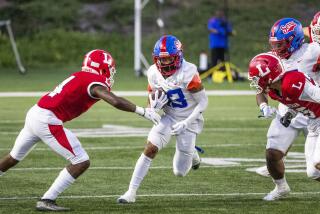Basketball, Bicycling Lead the Hurt Parade
- Share via
Baseball calls itself the national pastime, but a new survey finds basketball is not only the team sport with the most players, it’s the one making the strongest gains.
The catch is, as more people are playing basketball, more are getting hurt doing it.
More than 30 million played hoops at least once in 1995, a survey by the National Sporting Goods Assn. found.
However, 1995 data on hospital emergency room visits show basketball is the most injurious recreational activity.
Last year, almost 694,000 basketball injuries were examined in emergency rooms, said a report from the American Academy of Orthopedic Surgeons using statistics gathered by the U.S. Consumer Product Safety Commission.
Bicycling caused the second-most injuries, with nearly 600,000 cases, and football was third, with almost 390,200.
While the bone specialists like to see people play ball, they are worried about the basketball injury rates and believe many injuries could be prevented by proper training and conditioning.
“You can’t go out and try to play basketball when you haven’t done any sprinting for four, five, six months,” said Dr. Letha Griffin of Atlanta.
As an orthopedic surgeon, Griffin pays close attention to knee and ankle injuries, which accounted for about 271,400 of the emergency room diagnoses.
Players can protect their ankles with calf-strengthening exercises that build the muscles that work the ankles, Griffin said.
For instance, they can push against an object using their ankles. In doing this, they should keep their toes pointed down, so they work muscles in the back of the ankle, which stabilizes the joint, Griffin said. And players can strengthen the knee with weight training.
Practicing the game improves both play and safety, said Bernie DePalma, head athletic trainer at Cornell University. Jump shots and layups build neuromuscular coordination, he said.
Wearing bracing may also reduce the injury risk, DePalma said.
During the summer, the risk of heat injury also rises, and players need to drink plenty of water to reduce the risk.
But that’s not the only reason to drink a lot, said David L. Costill, director of the Human Performance Laboratory at Ball State University in Muncie, Ind. It also affects play, he said.
People who are low on water also lose endurance, Costill said.
What’s more, it only takes a 1% to 2% drop in body weight due to water loss to do this, Costill said. And, because thirst doesn’t start until well after the water is lost, people must make themselves drink even when they are not thirsty.
A simple way to prevent injury is to check the playground or court you’re playing on for grass, holes or bumps that could trip you, Griffin said.
More to Read
Go beyond the scoreboard
Get the latest on L.A.'s teams in the daily Sports Report newsletter.
You may occasionally receive promotional content from the Los Angeles Times.










